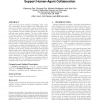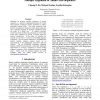39 search results - page 6 / 8 » The practical advantage of surprise-based agents |
ATAL
2005
Springer
14 years 27 days ago
2005
Springer
There has been much research investigating team cognition, naturalistic decision making, and collaborative technology as it relates to real world, complex domains of practice. How...
ATAL
2004
Springer
14 years 23 days ago
2004
Springer
Multi-agent research often borrows from biology, where remarkable examples of collective intelligence may be found. One interesting example is ant colonies’ use of pheromones as...
AAAI
2004
13 years 8 months ago
2004
Obtaining an accurate multiple alignment of protein sequences is a difficult computational problem for which many heuristic techniques sacrifice optimality to achieve reasonable r...
AAAI
1998
13 years 8 months ago
1998
Temporal plans permit significant flexibility in specifying the occurrence time of events. Plan execution can make good use of that flexibility. However, the advantage of executio...
ITS
1998
Springer
13 years 11 months ago
1998
Springer
We present a vision for learning environments, called Science Learning Spaces, that are rich in engaging content and activities, provide constructive experiences in scientific proc...


